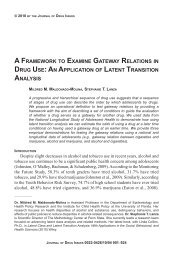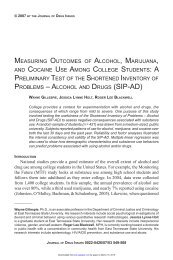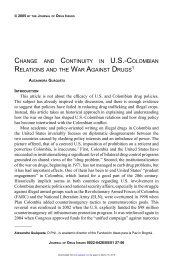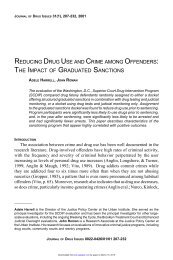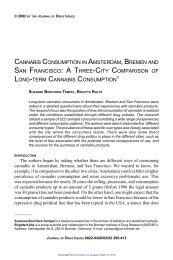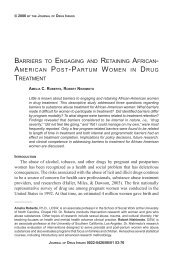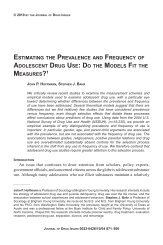a brief history of cannabis policies in spain - Journal of Drug Issues
a brief history of cannabis policies in spain - Journal of Drug Issues
a brief history of cannabis policies in spain - Journal of Drug Issues
You also want an ePaper? Increase the reach of your titles
YUMPU automatically turns print PDFs into web optimized ePapers that Google loves.
GAMELLA, JIMÉNEZ RODRIGO<br />
facilities were directed by pr<strong>of</strong>essionals, ex-addicts, and religious organizations<br />
(Polo & Zelaya, 1985). By 1986 an exhaustive survey found 81 therapeutic<br />
communities <strong>in</strong> Spa<strong>in</strong> <strong>of</strong>fer<strong>in</strong>g about 2,900 placements for drug dependency. A<br />
year later, the same author found that 23 new ones had opened (Comas, 1988, pp.<br />
58-60).<br />
The key element <strong>in</strong> the therapeutic community approach was to separate the<br />
addict from the daily context <strong>of</strong> the barrio where <strong>in</strong>jection and addiction had been<br />
generated and supported. These <strong>in</strong>stitutions tended to be located <strong>in</strong> the countryside.<br />
In fact, they were popularly referred to as “granjas” (“farms”). In many cases they<br />
developed a sect-like quality, <strong>in</strong> agreement with a particular religious or cult<br />
affiliation. For patients (or <strong>in</strong>mates), return to their home environment was <strong>of</strong>ten<br />
traumatic, and relapse was common.<br />
The therapeutic communities mandated total abst<strong>in</strong>ence from illegal drugs and<br />
<strong>of</strong>ten ardently rejected methadone dispensation as well. In fact, methadone<br />
substitution programs almost disappeared <strong>in</strong> Spa<strong>in</strong> between 1983 and 1991. These<br />
programs were not popular then, even among pr<strong>of</strong>essional therapists work<strong>in</strong>g with<br />
hero<strong>in</strong> addicts, or among the most active, vocal, and organized <strong>of</strong> the parents <strong>of</strong><br />
hero<strong>in</strong> addicts. Still, <strong>in</strong> 1990 a survey found that 40% <strong>of</strong> respondents opposed the<br />
dispensation <strong>of</strong> methadone, while 49% favored it (Martí, 1999). AIDS did not<br />
become a priority <strong>in</strong> the treatment <strong>of</strong> hero<strong>in</strong> addicts until about 1989-1990.<br />
In the 1990s therapeutic communities rema<strong>in</strong>ed a treatment option, although<br />
they were much controlled, regulated, and pr<strong>of</strong>essionalized. Slowly, diverse types<br />
<strong>of</strong> outpatient treatments were developed <strong>in</strong> primary health units.<br />
INSTITUTIONALIZATION OF THE WAR ON DRUGS<br />
By the late 1980s the National Plan on <strong>Drug</strong>s was be<strong>in</strong>g implemented at full<br />
speed. It was first and foremost a plan to confront the hero<strong>in</strong> crisis. Dozens <strong>of</strong><br />
epidemiologists, psychiatrists, psychologists, and adm<strong>in</strong>istrative personnel were<br />
coord<strong>in</strong>at<strong>in</strong>g the “<strong>of</strong>ficial response” to the hero<strong>in</strong> crisis. In the follow<strong>in</strong>g years,<br />
every regional and sizable municipal government developed its own “plan on drugs”<br />
with its lead<strong>in</strong>g political appo<strong>in</strong>tees, coord<strong>in</strong>at<strong>in</strong>g committees, technicians, social<br />
workers, and adm<strong>in</strong>istrative support. A number <strong>of</strong> NGOs were developed throughout<br />
the country to deal with the “problem <strong>of</strong> drugs,” most <strong>of</strong> them supported by public<br />
funds. In the first five years <strong>of</strong> its implementation (between 1986 and 1991), the<br />
National Plan on <strong>Drug</strong>s spent over $500 million, an amount funded both by the<br />
Central Government and the Autonomous Communities (Delegación del Gobierno<br />
para el Plan Nacional Sobre Drogas [DGPND], 1992, p. 33).<br />
Thus, the <strong>in</strong>stitutional response to the hero<strong>in</strong> crisis was slow to develop. A<br />
decade passed between the beg<strong>in</strong>n<strong>in</strong>g <strong>of</strong> the “epidemic” and the rigorous monitor<strong>in</strong>g<br />
<strong>of</strong> its extent and its consequences. The immediate pr<strong>of</strong>essional response was to<br />
632 JOURNAL OF DRUG ISSUES<br />
Downloaded from jod.sagepub.com by guest on March 15, 2015








